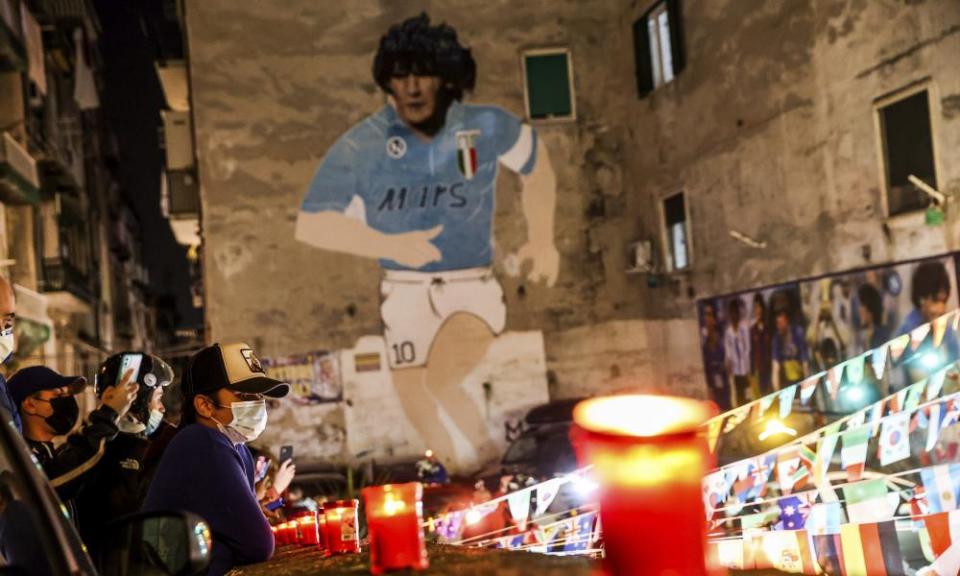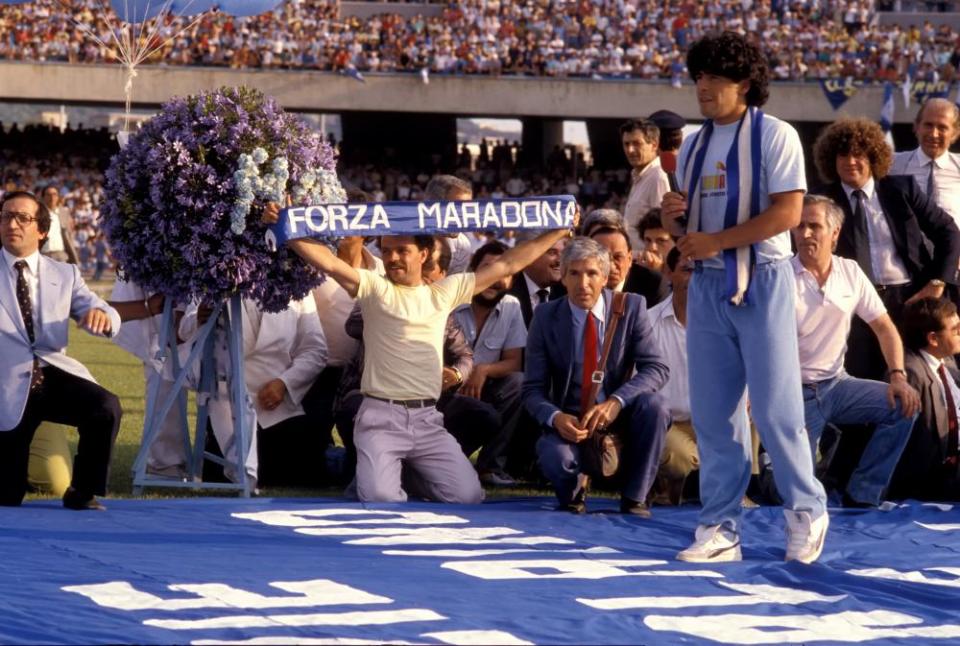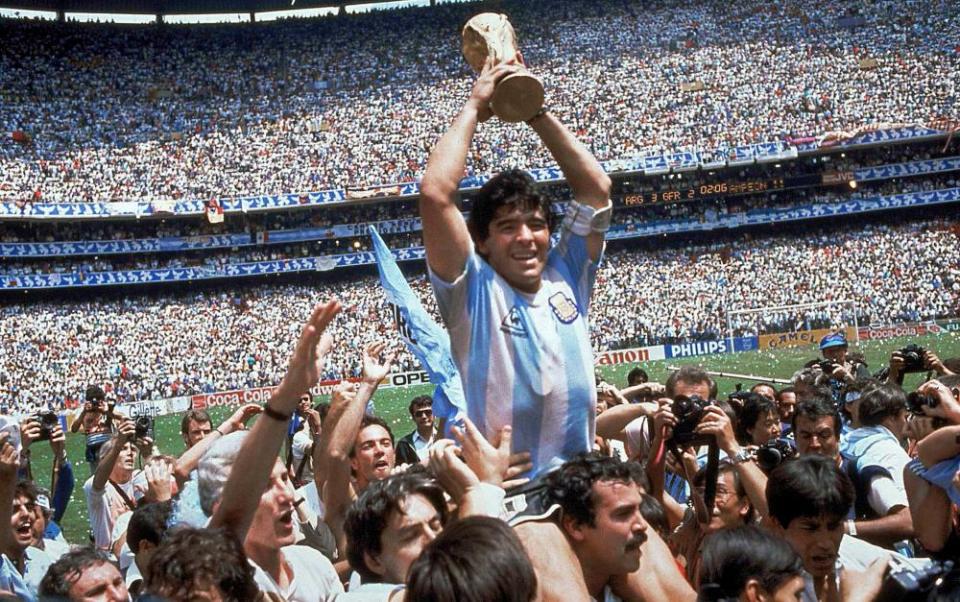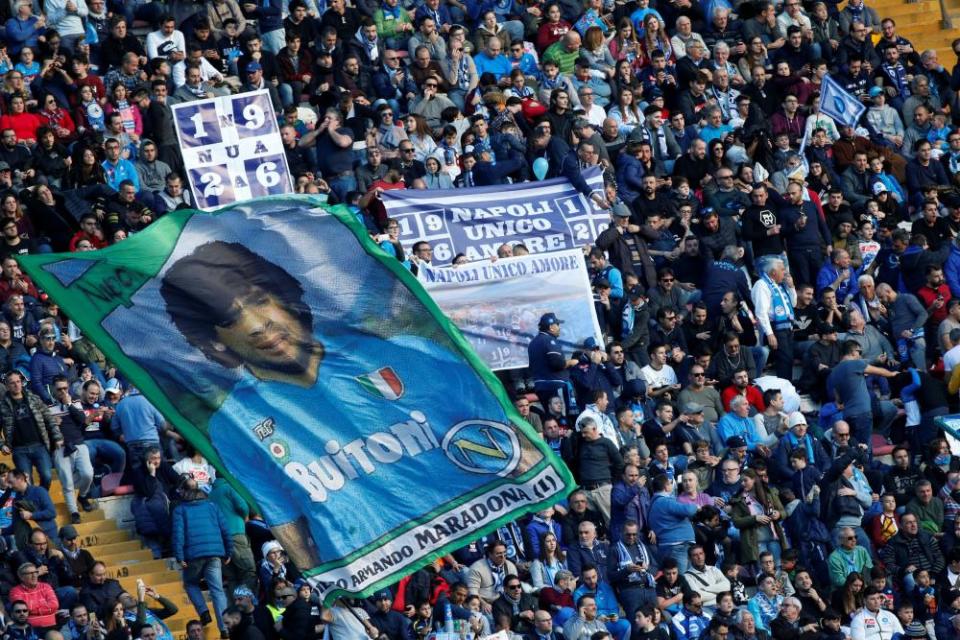In Naples, a city steeped in pagan rites, I saw Maradona cast his spell

On the evening that Napoli football club won its first ever championship, in May 1987, a graffito was scrawled on the wall of Poggioreale cemetery, on the city’s shoulders as it rises from the gulf of Naples: “Voi non sapete che cosa vi siete persi” – roughly, you don’t know what you missed. Overnight came the reply: “E chi u l’he detto?” – who told you we missed it?
This is how Naples thinks, and holds in its heart the mercurial genius largely responsible for winning that scudetto: Diego Maradona. And now that “Dieguito” himself has passed over to the other side, the city’s head of cemeteries, Alessio Castiello, and funeral director Gennaro Tammaro, urge the city to commission and erect a statue of, and monument to, Maradona.
“Besides him being an iconic figure,” said Tammaro, “losing Maradona is – for Neapolitans – like losing a member of the family. As soon as we heard the news, we immediately resolved to give the city a place where we can remember him and – why not? – cry.” Almost as Tammaro spoke, SSC Napoli announced the renaming of its San Paolo Stadium to Diego Armando Maradona Stadium.
Over the past days and nights of Argentinian mourning – passionate to the point of violence – crowds of Neapolitans have also gathered beneath murals of Maradona; there’s a bridge between Vesuvius and Buenos Aires, of vigils held, tears shed, prayers whispered, memories exchanged.
Life is nothing if not a storage of memories long gone but cherished, and among my own are those Sunday afternoons over two years with an abbonamento – season ticket – spent at San Paolo, watching Maradona play. Years of wonder, and poignant decline: Diego’s delivery of a second scudetto for Napoli in 1990; both triumph and tribulation during the 1990-91 season, then Maradona’s ensnarement by celebrity, the Camorra mafia and its white stuff – and his tragic departure.
Maradona hails from, belongs to, and will be rightly laid to rest in his beloved Argentina. His playing career began with Argentinos Juniors, then Boca Juniors, and ended back at Boca. Buenos Aires sports journalist Alejandro Wall wrote on Friday: “Diego is the great narrator of Argentina”, rising as he did from dire poverty in the barrio. Columnist Hugo Alconada Mon, writing in the daily La Nación, judged that in a riven nation, “Maradona was one of the few figures who, at least in certain moments, managed to unify us: his skill, his achievements, his myth and his legacy transcended his football… or politics… Maradona was unmistakably Argentine, and a universal genius.”

But – as he said himself, many times – Maradona leaves a slice of his soul in Naples. It was wearing Napoli’s sky-blue shirt that he found a spiritual, as well as professional, home. Mayor Luigi De Magistris on Wednesday called Maradona’s death “the latest tragedy in a terrible year. It was a visceral love. Maradona was Naples.”
Naples is the world’s last pagan city. It exists on a faultline and in the shadow of a volcano, in close proximity to the cults of death and after-life, replete with what atheists and northern Europeans call “superstition”. Family shrines – and several to Maradona, sometimes complete with halo – adorn corners and courtyards. The canyon-streets of peeling stucco around Spaccanapoli and Quartieri Spagnoli are lined with wart-faced marionettes, masks and pulcinelle harlequins. Even the frayed suburbs, among the poorest in Europe, are steeped in folklore: Neapolitans read cards in earnest, and interpret dreams with the smorfia – from Morpheus, god of dreams – a table of numbers which correlate to body parts and other symbols. People wear the cornicello for protection and to assist with fertility or virility. Catholicism in Naples can be richly occult: in the chapel of Sansevero, the marble veil over Christ’s body is so impossibly thin, so they say, it cannot have been carved by Giuseppe Sanmartino, and must have been draped over him and turned to stone with a spell.
This is the city to which Diego Maradona arrived in 1984; a capacity crowd filled the stadium – and streets around it – just to greet the man Naples heralded as its Messiah.
Maradona’s football befitted a city steeped in magic. His ball control, the weird trajectory of his shooting, the weighting of a pass; his body-swerves and inability to fall over, defied the laws of physics and gravity. Maradona was a soccer-sorcerer; he played in a fifth dimension and could mind-read an opponent before he himself knew what he was thinking. Maradona’s tricks never repeated themselves; there was no pattern to read, no code to crack. He played football like a voodoo shaman, and Naples understood exactly what was happening.
There was also deep history beneath what Maradona achieved. Naples was once Italy’s biggest city, but with Italian unification during the 1850s and 60s, it lost hegemony to the industrialising north. The port became a gateway of flight to America as the south was impoverished, while Piedmont, Lombardy and Veneto flourished. And this, like everything in Italy, was reflected in football: the apparently never-ending reigns of formidable Juventus, and Milan’s brace of powerhouse clubs.
The north held Naples in contempt; the songs at matches spoke for themselves: “Here come the Neapolitans/ Oh, what a stench!/Even the dogs are running away/ Terremotati, Colerati… [literally: earthquaked, cholera-ridden]”.
This narrative was carved into the city’s subconscious when Maradona captured the two championships: more than victories, they were deliverance and vindication. Then came Italy’s turn to host the 1990 World Cup and face Argentina at San Paolo for the semi-final. While Italians saw the trophy on home terrain as an almost divine right, Maradona pleaded that the crowd commit treason and support his homeland team. Most present did not – nor did I – but the Ultras on the stadium’s Curva B did, for sure; “Napoli non è Italia,” insisted Maradona [Naples is not Italy].

Argentina won, Italy’s showcase was shattered, and the country – public, judges and newspapers – never forgave Maradona.
In Naples, the brighter the sun and colours, the darker the shadows fall. “Napule è nu sole amaro” – “Napoli is a bitter sun” – reads a neon sign in dialect strewn across the main street through Sanità, a line from a song by Pino Daniele. And even back then, before the brave work of Roberto Saviano made it infamous, the Camorra was tightening its grip not only on the city’s economy and political class of Campania but also on Europe’s share of the global cocaine market.
Maradona was the perfect quarry: passionate, anxious to please and be pleased; over-generous, almost naive. He attracted money and could be made dependent – on cocaine, and on sex to a degree – and thereby on those who provided them. Maradona was courted and worn by bosses of the Giuliano Camorra clan as a badge of credibility, with regard to both the establishment and the people. Naples adulated but devoured him.
By the time of Italy’s semi-final loss to Argentina, Maradona himself had edged ajar the doorway to his own destruction – and now the machinery of state pushed it wide open. So on weekdays, between watching Maradona play, I found myself, as a reporter rather than fan, listening to his voice on police wiretaps. One night, a Camorra madam called Donna Carmela Cinquegrana put her son Cristino on the line for a chat with his idol, before procuring him a pair of prostitutes.
After Maradona left Naples as a player for the last time, a warrant for drug possession over his head, another graffito appeared: Diego, “facci ancora sognare” – Diego, make us dream again.
So much has been written and filmed about Maradona’s fall, we can forget that Diego’s life, work and charisma survived and continued after Naples, as he rebounded from humiliation to defiance, from rehab to politics, and charted a course from football management career to papal audience, and global celebrity.
Maradona’s football befitted a city steeped in magic. He played like a voodoo shaman, and Naples understood exactly
Maradona confidently befriended leftist leaders throughout the Americas: Cuba’s Fidel Castro, Venezuela’s Hugo Chávez, Argentina’s Cristina Fernández de Kirchner, Bolivia’s Evo Morales. For whatever reason, it matters not: Maradona became an icon not just of football but of the barrio poor, sporting his tattoo of Che Guevara. Among the avalanche of tributes last week was that from American sports writer Dave Zirin, praising Maradona’s “rebel intensity”, as a “friend and fierce advocate for all trying to eke out survival in a world defined by savage inequalities”.
A marvellous series on Netflix followed Maradona’s two seasons as manager of the Dorados de Sinaloa, based in Culiacán, fortress capital of Joaquín “El Chapo” Guzmán’s drug business. It seemed like a disaster waiting to happen: Diego in cocaine’s capital. Not so: the seven films show him taking a Mexican second division team playing on a pitch of barely growing grass, to the cup final, through sheer soccer-savvy, and belief in the redemptive joy of football.
Series producer Angus MacQueen recalls: “We imagined that in Culiacán, run by the Sinaloa cartel, we would get some tragic, disastrous shadow of Diego’s Neapolitan triumphs. Instead, we lived with his raw passion, his desire to win, his drive. And yet, I have never met anyone who felt more alone, who so wanted to be loved. The football pitch was his escape. As he said to us: ‘it was like touching heaven.’”
As the only player to whom Maradona is compared, Pelé, said on Wednesday: “I hope one day, we’ll play football together in heaven.”

Back in Naples, I interviewed a man called Pepe who had known Maradona well, and to whom he confessed: “I’m not a saint, I’m a football player.” And the most arresting reactions to his death come from his adversaries on the pitch, and those who have sought to follow in his footsteps – the community of great players, most of whom, like Diego, rose from the slums.
Michel Platini, whom people called “the other number 10”, captained probably the best team ever to play – Juventus – during the 1980s. He said on Thursday: “Our own past has passed away.” In an insightful interview with La Repubblica on Friday, Platini expanded: “[Maradona’s] game was magical and magnificent, and I won’t allow myself into his personal life... But I don’t remember Diego alone. He was always with his audience… he had a carnal need for contact. Wherever there was a crowd, there you’d find Diego, sweaty and happy. He loved being loved… However, I think that within himself, away from the crowd, he felt alone all his life.”
Platini recalls playing against Maradona in his farewell game for Juve, in 1987: “We exchanged shirts, after he had played every one of those 90 minutes.”
The generation that follows holds him in awe. Zlatan Ibrahimović, top scorer in Serie A, for Milan, two decades after joining Ajax, aged 20, said: “[Maradona’s] not dead. He’s immortal. God gave us the greatest player of all time, and he’ll live for ever.”
Best of all, from Tono Nuñez, president of Dorados de Sinaloa, who lured Maradona to Culiacán: “Trainers try to convince players to work hard, practise and believe in their tactics. But Maradona gets them to give their best just by showing up! He was defiant, stubborn, fragile at heart.” And on Maradona’s passing: “Every minute, there’s a tear. And then comes this big laugh!”

 Yahoo Sport
Yahoo Sport 





































